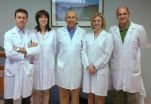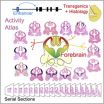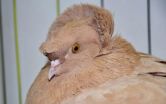(Press-News.org) This press release is available in Spanish.
The relationship between genetics and Parkinson's has been investigated for more than a decade, but it is only over the last few years that significant results have begun to be obtained. The first mutations related to the development of this disease were found in 2004. A team from the UPV/EHU-University of the Basque Country came across a mutation of the LRRK2 gene, which is particularly prevalent among the population of Gipuzkoa. It is the R1441G mutation and is known as the Basque mutation. Now, Doctor Javier Ruiz, a doctor on the same team, has submitted a thesis in which he has studied this mutation; apart from the study of its prevalence, the study includes the calculation of its penetrance, the description of its clinical phenotype, its progression, and the neuropathological study of a patient carrying this mutation. The results have been published in the prestigious journals Neurogenetics and Movement Disorders.
In actual fact, it was no easy task relating Parkinson's with certain genes. "At first, one-off descriptions were made and they pointed to the old idea that Parkinson's was something sporadic, but this is not true," says Ruiz, the author of the study. When a decade ago people began to say that there were family forms, the genes were not these ones. They were genes that accounted for a type of Parkinson's that was slightly different, and which was somewhat removed from the classical Parkinson's that we could all see.
The gene studied by Ruiz's team and which codifies the protein they called dardarina, does, however, explain a type of Parkinson's which is the common one. Nevertheless, that gene is not the only one related to the disease. "Right now, genes continue to be discovered," explains Ruiz. "There is a list of about 15 or 16 genes involved in the monogenic forms of Parkinson's, in other words, forms of the disease that can be associated with a specific mutation. This gene is the most important from the point of view of frequency, it is the one most seen in the world population."
However, it is not known what dardarina, the protein that encodes the gene studied, actually does. One of the lines of research is seeking the function of dardarina from the point of view of neuronal death, since it is linked to this process in certain specific brain structures, but its exact role is not yet known.
"Different mutations of the gene are known to cause the protein to do different things, but what the so-called Basque mutation actually does is not fully understood. There is another mutation that is more prevalent worldwide, the G2019S, which is the best known one. It has a more enzymatic activity; it is a kinase, in other words, a protein that transfers phosphate groups from one molecule to another," says Ruiz.
Questions and answers
In this thesis Ruiz studied four families in Gipuzkoa who have the R1441G mutation, and he did this from a range of perspectives. "Well, I've got families with Parkinson's and I want to know why. I do research, but I'm also a clinician, and I'm in contact with patients every day, and the questions I get from them I then transfer to the research," he says.
Ruiz says that the first question is about knowing what having a mutation means. It is the study of penetrance that he did in his thesis; "having a mutation means that by the time you're 80 you have an 83% chance of having Parkinson's," he explains.
Another question is whether the mutation is something by chance or is frequent in the Basque Country. What is more, Ruiz has studied whether the mutation only appears in the patients or whether it is common in the general population. That is why he took samples from people in Azpeitia and Azkoitia, which is where the highest number of patients are, and he found that 1.8% of the general population have it.
He also looked into whether the Parkinson's associated with this mutation, R1441G, is similar to that associated with the G2019S. "Studying the non-motor symptoms is very much in vogue in Parkinson's research," says Ruiz. The result of the study indicates that these symptoms are less present in the case of the Basque mutation.
"And armed with this, what can I contribute to science and to my patients? Well, an early diagnosis perhaps, and having a target population that could be the first to benefit from a future neuroprotective treatment, which, it has to be said, does not yet exist," says Ruiz. That is why another part of the research has focused on the quest for biomarkers in people carrying the mutation, since they indicate who has a greater risk of contracting the disease. The study proposes olfactory dysfunction and sympathetic dysfunction measured by cardiac gammagraphy as markers to be studied.
Besides the results obtained, the thesis also points to the lines along which the research needs to be continued. "You owe that to the population; the patients' relatives have altruistically donated their blood to enable us to do this study," explains Ruiz. "We will have to give them answers."
INFORMATION:
Javier Ruiz-Martínez is a neurologist in the Parkinson's and Other Motor Disorders' Unit of the Neurology Service of the University Hospital of Donostia-San Sebastian and of the Neurociences Area of the Biodonostia Research Institute. He did his PhD thesis at the UPV/EHU under the supervision of the doctors José Félix Martí-Massó and Adolfo López de Muniain.
Examining the so-called Basque mutation of Parkinson's
Javier Ruiz's Ph.D. thesis has studied this mutation in four families in Gipuzkoa (Basque Country)
2013-02-01
ELSE PRESS RELEASES FROM THIS DATE:
NASA sees a coronal mass ejection erupt from the sun
2013-02-01
On Jan. 31, 2013 at 2:09am EST, the sun erupted with an Earth-directed coronal mass ejection or CME. Experimental NASA research models, based on observations from the Solar Terrestrial Relations Observatory (STEREO) and ESA/NASA's Solar and Heliospheric Observatory, show that the CME left the sun at speeds of around 575 miles per second, which is a fairly typical speed for CMEs. Historically, CMEs at this speed are mild.
Not to be confused with a solar flare, a CME is a solar phenomenon that can send solar particles into space and reach Earth one to three days later.
Earth-directed ...
The effective collective: Grouping could ensure animals find their way in a changing environment
2013-02-01
For social animals such as schooling fish, the loss of their numbers to human activity could eventually threaten entire populations, according to a finding that such animals rely heavily on grouping to effectively navigate their environment.
Princeton University researchers report in the journal Science that collective intelligence is vital to certain animals' ability to evaluate and respond to their environment. Conducted on fish, the research demonstrated that small groups and individuals become disoriented in complex, changing environments. However, as group size is ...
Evidence of geological 'facelift' in the Appalachians
2013-02-01
How does a mountain range maintain its youthful, rugged appearance after 200 million years without tectonic activity? Try a geological facelift – courtesy of the earth's mantle.
Researchers from North Carolina State University noticed that a portion of the Appalachian Mountains in western North Carolina near the Cullasaja River basin was topographically quite different from its surroundings. They found two distinct landscapes in the basin: an upper portion with gentle, rounded hills, where the average distance from valley to mountain top was about 500 feet; and a lower ...
Genome-wide atlas of gene enhancers in the brain online
2013-02-01
Future research into the underlying causes of neurological disorders such as autism, epilepsy and schizophrenia, should greatly benefit from a first-of-its-kind atlas of gene-enhancers in the cerebrum (telencephalon). This new atlas, developed by a team led by researchers with the U.S. Department of Energy (DOE)'s Lawrence Berkeley National Laboratory (Berkeley Lab) is a publicly accessible Web-based collection of data that identifies and locates thousands of gene-regulating elements in a region of the brain that is of critical importance for cognition, motor functions ...
New role for DNA methylation in subset of premature aging disorder patients
2013-02-01
Scientists at the Bellvitge Biomedical Research Institute in Barcelona, Spain have found new evidence for the role of epigenetic changes (those heritable alterations in gene expression caused by mechanisms other than changes in DNA sequence) on premature aging diseases. A new study published in the journal Epigenetics on Jan. 1, 2013, identified a role for DNA methylation changes in a subset of Hutchinson-Gilford Progeria and Werner Syndrome patients, for which no genetic cause (such as DNA mutation) had been associated with onset disease. The study, titled "Aberrant DNA ...
Safe sex practices among African American women
2013-02-01
Los Angeles, CA (January 31, 2013) Researchers have found that African American women exhibit a higher risk for sexually transmitted infections including HIV/Aids. But what motivates this group of women to have sex? And when are they more likely to use protection?
A new study published today in Health Education & Behavior (a SAGE journal) found that regardless of motivations for having sex, condom use expectations were less than 50% for all types of sexual encounters, including the riskiest types of sex.
Researchers Julianna Deardorff et. al used a combination of interviews ...
Men taking long-acting chronic pain meds 5xs more likely to have low testosterone levels
2013-02-01
OAKLAND, Calif., January 31, 2013 — Low testosterone levels occur five times more often among men who take long-acting instead of short-acting opioids for chronic pain, according to a new Kaiser Permanente study published in The Clinical Journal of Pain.
While it has been known that opioids cause low testosterone in men, this study is the first to show a significant difference in risk between short-acting (immediate release) and long-acting opioids.
The 81 men in the retrospective study were between 26 and 79 years old (median age 51) and were seen in the chronic-pain ...
New device traps particulates, kills airborne pathogens
2013-02-01
A new device called a soft x-ray electrostatic precipitator protected immunocompromised mice from airborne pathogenic bacteria, viruses, ultrafine particles, and allergens, according to a paper published online ahead of print in the journal Applied and Environmental Microbiology. This device, known for short as a SXC ESP, is highly versatile, with multiple potential uses, and Washington University is working on licensing the technology.
"Small particles are difficult to remove, and our device overcomes that barrier," says Pratim Biswas of Washington University, St. Louis. ...
Mutant gene responsible for pigeons' head crests
2013-02-01
Scientists have decoded the genetic blueprint of the rock pigeon, unlocking secrets about pigeons' Middle East origins, feral pigeons' kinship with escaped racing birds and how mutations give pigeons traits like feather head crests.
"Birds are a huge part of life on Earth, but we know surprisingly little about their genetics," says Michael Shapiro, one of the study's two principal authors and a biologist at the University of Utah.
In the new study, "we've shown a way forward to find the genetic basis of traits--the molecular mechanisms controlling animal diversity in ...
Just 11 percent of adults, 5 percent of children participate in medical research
2013-02-01
ANN ARBOR, Mich. – Medical research is vital to the advancement of health care, but many medical research studies have too few people who participate. A new study from the University of Michigan takes an in-depth look at public participation in medical research across the United States.
Through a unique, nationally representative survey of 2,150 households in 2011, University of Michigan researchers found that only 11% of adults and 5% of children had ever participated in medical research. The study was published in January in Clinical and Translational Science.
About ...
LAST 30 PRESS RELEASES:
Eye for trouble: Automated counting for chromosome issues under the microscope
The vast majority of US rivers lack any protections from human activities, new research finds
Ultrasound-responsive in situ antigen "nanocatchers" open a new paradigm for personalized tumor immunotherapy
Environmental “superbugs” in our rivers and soils: new one health review warns of growing antimicrobial resistance crisis
Triple threat in greenhouse farming: how heavy metals, microplastics, and antibiotic resistance genes unite to challenge sustainable food production
Earthworms turn manure into a powerful tool against antibiotic resistance
AI turns water into an early warning network for hidden biological pollutants
Hidden hotspots on “green” plastics: biodegradable and conventional plastics shape very different antibiotic resistance risks in river microbiomes
Engineered biochar enzyme system clears toxic phenolic acids and restores pepper seed germination in continuous cropping soils
Retail therapy fail? Online shopping linked to stress, says study
How well-meaning allies can increase stress for marginalized people
Commercially viable biomanufacturing: designer yeast turns sugar into lucrative chemical 3-HP
Control valve discovered in gut’s plumbing system
George Mason University leads phase 2 clinical trial for pill to help maintain weight loss after GLP-1s
Hop to it: research from Shedd Aquarium tracks conch movement to set new conservation guidance
Weight loss drugs and bariatric surgery improve the body’s fat ‘balance:’ study
The Age of Fishes began with mass death
TB harnesses part of immune defense system to cause infection
Important new source of oxidation in the atmosphere found
A tug-of-war explains a decades-old question about how bacteria swim
Strengthened immune defense against cancer
Engineering the development of the pancreas
The Journal of Nuclear Medicine ahead-of-print tip sheet: Jan. 9, 2026
Mount Sinai researchers help create largest immune cell atlas of bone marrow in multiple myeloma patients
Why it is so hard to get started on an unpleasant task: Scientists identify a “motivation brake”
Body composition changes after bariatric surgery or treatment with GLP-1 receptor agonists
Targeted regulation of abortion providers laws and pregnancies conceived through fertility treatment
Press registration is now open for the 2026 ACMG Annual Clinical Genetics Meeting
Understanding sex-based differences and the role of bone morphogenetic protein signaling in Alzheimer’s disease
Breakthrough in thin-film electrolytes pushes solid oxide fuel cells forward
[Press-News.org] Examining the so-called Basque mutation of Parkinson'sJavier Ruiz's Ph.D. thesis has studied this mutation in four families in Gipuzkoa (Basque Country)




